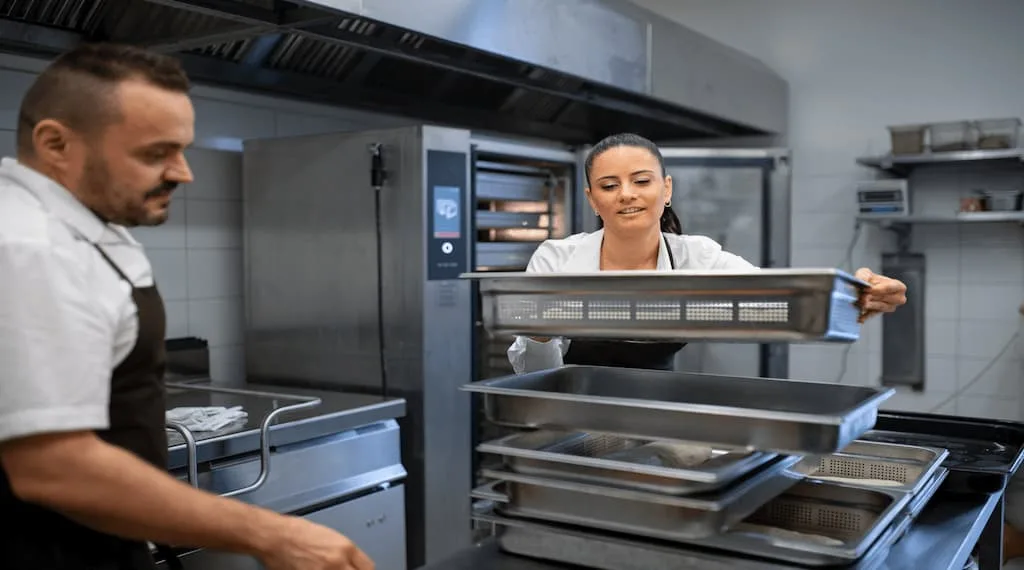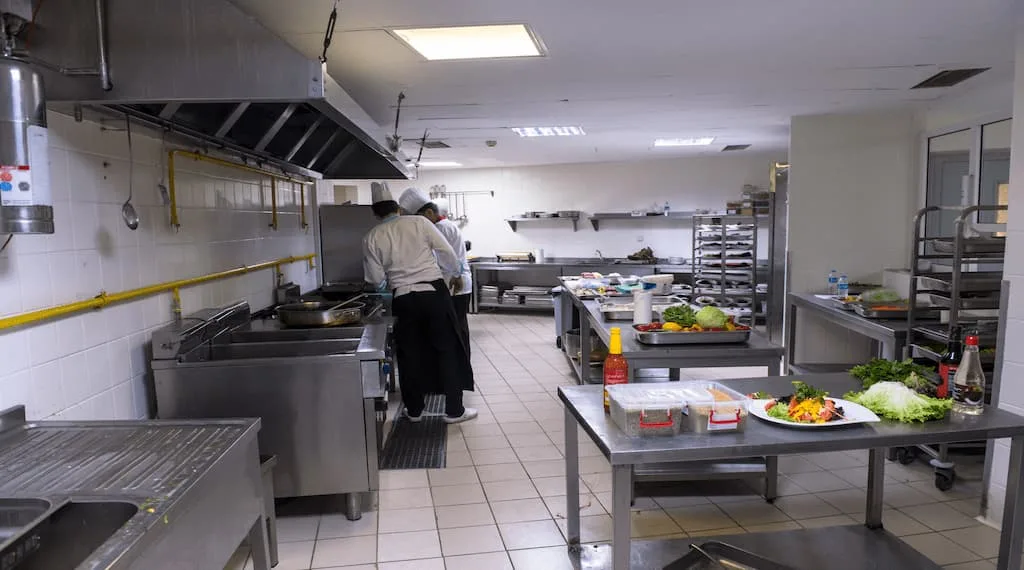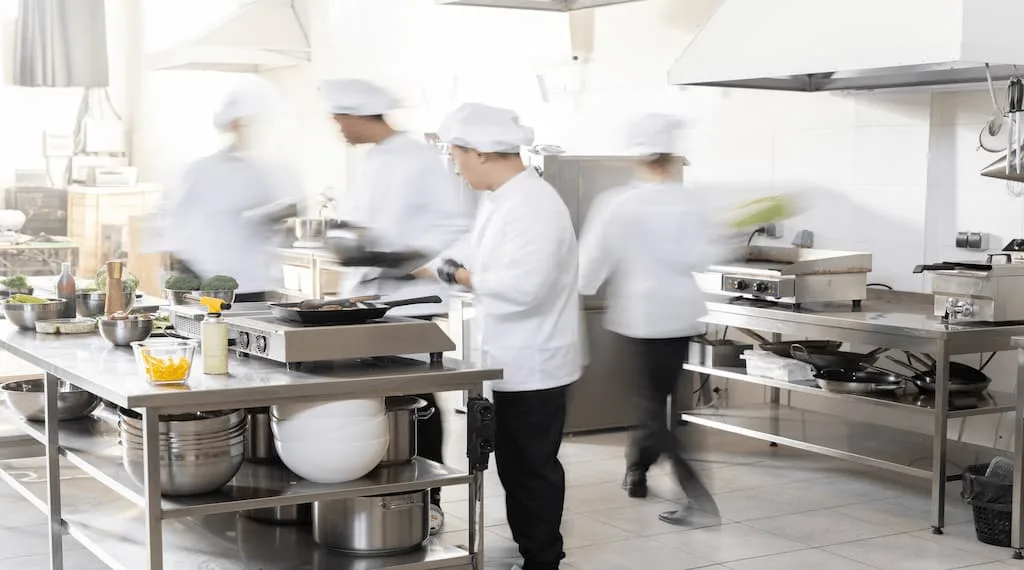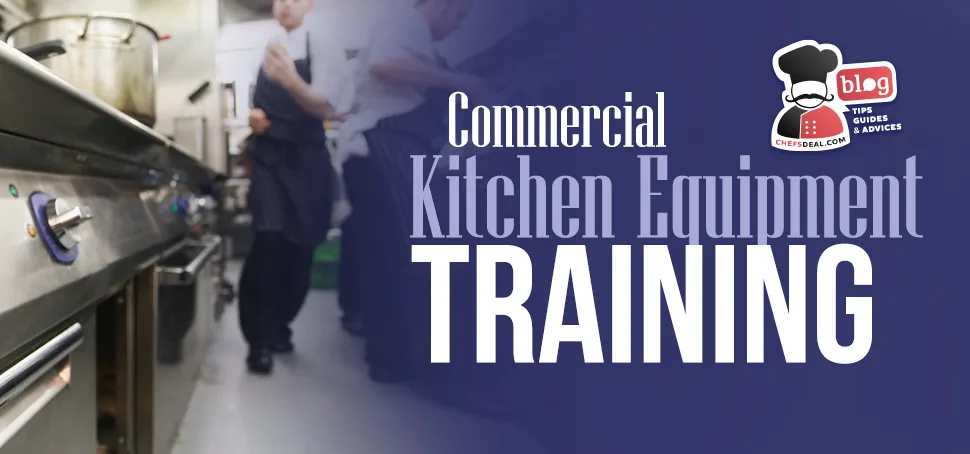Ergonomics in the kitchen refers to the design and arrangement of the kitchen space and equipment to maximize efficiency, safety, and comfort. It involves considering how kitchen tasks are performed and creating an environment that reduces strain and injury risks while improving the overall workflow.
What is The Importance of Ergonomics in The Kitchen?
Ergonomics in the kitchen, particularly in commercial settings, is a critical aspect beyond mere aesthetics. It’s about designing a workspace that aligns with the users’ physical capabilities and limitations, ensuring comfort, safety, and efficiency. This concept is especially pivotal in commercial kitchen design, where staff spend long hours performing repetitive tasks under time pressure.
Ergonomics in the kitchen and its profound impact on the well-being of staff and the overall operational efficiency of commercial kitchens. Ergonomic principles transform a busy kitchen into a productive, safe, and comfortable environment, thus contributing significantly to the success of any culinary enterprise. Understanding and implementing ergonomic design is not just about compliance with health and safety standards; it’s about creating a workspace that supports the physical health of the staff and enhances the workflow, ultimately reflecting the quality of service and food preparation.
What is The Impact of Ergonomics on Staff?
Implementing ergonomics in the kitchen has a profound impact on staff well-being and productivity.
- Reducing Physical Strain: Ergonomic design is crucial in preventing workplace injuries, particularly in the high-energy environment of a commercial kitchen. By tailoring the workspace to fit the physical needs of the staff, ergonomic design reduces the risk of musculoskeletal disorders, which are common in environments requiring repetitive movements or prolonged standing. By mitigating physical strain, ergonomics play a vital role in maintaining a healthy and injury-free workforce.
- Enhancing Staff Morale and Efficiency: A comfortable work environment, enhanced by ergonomic design, directly improves staff morale and productivity. Employees who work in a physically comfortable space and reduce strain will likely experience higher job satisfaction. This positive work atmosphere leads to increased motivation and engagement, boosting productivity. Ergonomically designed kitchens also facilitate smoother workflows and efficient movement, enabling staff to perform tasks more effectively and with less effort. This efficiency improves the speed of service and enhances the quality of the culinary experience delivered to customers.

What is The Basics of Ergonomics in The Kitchen?
The basics of ergonomics in the kitchen encompass a series of design principles and practices aimed at enhancing the comfort and efficiency of those working in a kitchen setting. This approach prioritizes the alignment of the kitchen’s design with ergonomic standards to ensure a harmonious interaction between the staff and their work environment. It includes thoughtful considerations of task workflows, special organization, and the selection of equipment and its layout, all directed toward minimizing physical discomfort and maximizing productivity:
What are The Important Work Surfaces Heights in The Kitchen?
Adjusting countertops, cooktops, ranges, sinks, shelves, and storage heights are the most important work surface areas in a commercial kitchen, minimizing bending or stretching of the staff. The placement of all makes a huge impact on movement and performance of working when located a few inches above or below. Applying the ideal operating heights in the kitchen provides mobility, reduces tiredness by ensuring healthy posture, and enhances efficiency and staff performance.
Countertop Height
The ideal height of a countertop is around 33.5-37.5 inches (or 85 to 95 cm); in another recommendation, it’s between 37-40 inches (94-102 cm). The ideal working height of a countertop is determined by a person’s elbow position in a healthy posture. Staff elbows should rest with their forearms at a 45-degree angle from the surface while palms down on the countertop. It will give the workers an ergonomic and comfortable working height, diminishing back pain.
Cooktop/Range Height
The ideal cooktop height should be a few inches lower than the countertop so the user can easily see the inside pots and pans. Pots and pan rims can be referenced in calculating the ideal cooktop height. Adjustable height cooktop ranges are a good option to consider. Don’t forget to adjust the height of the range hood to prevent accidents.
Sink Height
The ideal height of a kitchen sink is not calculated by the height of the rim but by the depth to the bottom of the sink. In an ergonomic sink design, the worker’s palm should reach the bottom of the sink while maintaining a healthy posture. The faucet height should be adjusted considering the size of the pots and pans and splash back depending on the sink depth while washing dishes or food.
Shelf and Storage Bin Height
The ergonomic reaching height for the shelves and bins is above eye level. It can also be measured by the elbow height when a person reaches up above his head. Continually bending down to the dishwasher and reaching up to shelves or dishwasher rack may cause back pain and health problems in the long run. Placing equipment at proper reaching height and near storage saves a lot of time and back pains.
Using up shelves and storage bins for heavy things is not recommended. To avoid the strain of lifting heavy objects while reaching up, bins and drawers below countertops are ideal for heavy and often used tools. Using sliding doors instead of classic doors opening outwards will provide easier use and movement in the kitchen. Contrary to popular belief, placing equipment like ovens and dishwashers at chest height is more efficient than placing them under the counter, removing the need for constant bending.
Equipment Placement
Strategically placing frequently used items and equipment within easy reach reduces unnecessary movement and improves workflow efficiency. You should also consider ergonomics before purchasing commercial kitchen equipment.
Equipment Design
Picking tools and equipment designed considering the human body and comfort, such as adjustable height, easy-to-clean materials, ergonomic handles, and easy access features, contribute to a more comfortable operation. For example, ovens designed to be placed at waist level will avoid constant bending down to reach, diminishing aches. Energy-efficient equipment, on the other hand, saves money and reduces heat production, enhancing working conditions in the kitchen. You can also check our article about The Importance of Ergonomic Kitchen Equipment for further information.
Flooring
Choosing anti-fatigue and slip-resistant flooring materials reduces the physical stress on legs and feet and prevents accidents. With proper flooring, you can minimize the fatigue of constant standing and walking. Cork and bamboo are far softer on the body than conventional and tiled kitchen flooring. Additional kitchen mats placed strategically, such as in stove and sink areas, preserve wooden flooring from satins while providing smoother steps for workers. It is also essential to have slip-resistant flooring in a commercial kitchen where spills occur all the time for a safer environment.

Lighting
Implementing adequate, glare-free lighting improves visibility and reduces eye strain, especially in task-intensive areas, such as chopping with a big chef knife or cooking many dishes. The lighting should placed strategically to avoid shadows for efficient working.
Ventilation
Effective ventilation in commercial kitchens is a regulatory requirement; it’s a crucial element for maintaining a healthy and comfortable working environment. Proper ventilation systems play a pivotal role in preserving air quality and regulating temperature, which are essential for safety, health, and comfort in high-heat, high-pressure kitchen settings.
Storage Solutions
Incorporating ergonomic storage solutions in commercial kitchens is vital for enhancing efficiency and reducing physical strain on staff. Ergonomically designed storage systems, such as pull-out drawers and adjustable shelving, significantly improve the kitchen workflow and staff comfort.
Optimizing Space
You can apply ergonomics in the kitchen by creating areas for different tasks such as prepping, cooking, plating, and dishwashing to provide efficient workflow. Efficient space utilization and low foot traffic will lead to quicker and easier movement and overall operation.
The space between the workstations is another essential point in establishing an ergonomic kitchen. Between the workstations, there should be enough space to provide mobility and no wasted square footage. The typical ergonomic space between workstations is 41 to 47 inches (105 to 120 cm).
The kitchen work triangle is a popular design tip to maintain effective access between the three most used kitchen work areas: the prep area, cooking station, and storage. You can adapt it by first finding the staff’s most common work points and drawing a flowing path between them. You can draw a line from the beginning of the food to the service and back to the dishwasher. Keep this path as uninterrupted as possible.

What are The Benefits Of Ergonomics in The Kitchen?
Ergonomics has several benefits in the kitchen, such as streamlined workflow and improved productivity, which is cost-saving in a business where time is money and provides a safer work environment.
Enhanced Productivity
Ergonomics in the kitchen boosts efficiency, morale, and productivity by providing a comfortable working area and minimizing injuries. The staff doesn’t perform needless movements and saves time by optimizing the kitchen space and creating room for free workflow. The strategically placed equipment and storage ensure everything is accessible, leading to quicker prep and serving time.
Reduced Health Problems
Working in a commercial kitchen is demanding, with health concerns on the side most of the time. Ergonomics in the kitchen are designed to reduce the strains, tiredness, and health issues deriving from repetitive tasks. Businesses create a safer atmosphere for the staff by utilizing ergonomic design tips and tools such as height adjustments, slip-resistant surfaces, and flooring ideas.
Improved Employee and Customer Experience
Employee satisfaction is a key to creating a productive and peaceful workplace. Creating a kitchen designed for your employee’s comfort demonstrates that you care about their health and well-being, encouraging employee morale and letting them focus on their tasks, increasing work quality. Improving staff happiness also improves customer service since the more efficient your team is, the faster food will be plated and provided to the client.

Conclusion: Embracing Ergonomics for a Better Kitchen Environment
Embracing ergonomics in commercial kitchen design is a comprehensive approach toward creating safer, more efficient, and more comfortable working environments. Commercial kitchens can become more than just food preparation areas by focusing on the basics of ergonomics, including adjusting work surfaces, optimizing equipment placement, and considering vital aspects like lighting and ventilation. They become environments where efficiency, safety, and comfort merge, improving staff morale and productivity.
Adopting ergonomic design is not just about minimizing the physical strain on staff; it’s about enhancing the overall functionality and flow of the kitchen. This holistic approach to kitchen design ensures that every aspect, from the heights of countertops to the placement of storage solutions, is tailored to reduce fatigue, prevent injuries, and streamline operations.
In essence, an ergonomic kitchen is a commitment to creating a harmonious and sustainable work environment. It’s an investment in the health and satisfaction of staff, reflecting the quality of service and culinary excellence delivered to patrons. As we continue to evolve in our understanding of ergonomics in the kitchen, we pave the way for more innovative, human-centered design solutions that shape the future of commercial cooking spaces.






